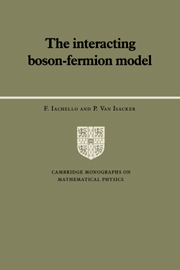Book contents
- Frontmatter
- Contents
- Preface
- Part I The interacting boson-fermion model-1
- 1 Operators
- 2 Algebras
- 3 Bose-Fermi symmetries
- 4 Superalgebras
- 5 Numerical studies
- 6 Geometry
- Part II The interacting boson-fermion model-2
- Part III The interacting boson-fermion model-K
- Part IV High-lying collective modes
- References
- Index
6 - Geometry
Published online by Cambridge University Press: 07 October 2009
- Frontmatter
- Contents
- Preface
- Part I The interacting boson-fermion model-1
- 1 Operators
- 2 Algebras
- 3 Bose-Fermi symmetries
- 4 Superalgebras
- 5 Numerical studies
- 6 Geometry
- Part II The interacting boson-fermion model-2
- Part III The interacting boson-fermion model-K
- Part IV High-lying collective modes
- References
- Index
Summary
Introduction
Every algebraic structure has associated with it geometric structures. The choice of the geometric structure with which it is most convenient to visualize the situation depends on the physics that one wishes to expose. For boson systems of the type discussed in Volume 1 and also for those used in the description of molecules (Iachello and Levine, 1982), there is a very natural geometric structure provided by the coset space U(n)/U(n – 1)⊗ U(1). This leads in the case of nuclei to a description in terms of five variables, αμ (μ = 0, ±1, ±2), which can then be associated with the shape of a liquid drop with quadrupole deformation (Bohr and Mottelson, 1975). Similarly, in molecules, use of the coset space mentioned above leads to a description in terms of three variables, rμ (μ = 0, ±l), which can be associated with the vector distance between the two atoms in the molecule.
For fermionic systems or when bosons and fermions coexist, the introduction of a geometric space is not so obvious. One can, if one wishes, introduce coset spaces, as briefly discussed in the following section, but even with this introduction, the geometric structure of the problem remains as abstract as before. A simpler situation arises if one is interested only in the case of a single fermion coupled to a system of bosons. In this case one can analyze the algebraic structure in terms of the motion of a single particle in a potential well generated by the bosons.
Information
- Type
- Chapter
- Information
- The Interacting Boson-Fermion Model , pp. 206 - 218Publisher: Cambridge University PressPrint publication year: 1991
